Exploration and Exploitation: Research Methodology Report Analysis
VerifiedAdded on 2020/02/03
|7
|1670
|229
Report
AI Summary
This report delves into the research methodology employed in a study focusing on exploration and exploitation. It begins by outlining the research approach, emphasizing the deductive method, and the interpretivism philosophy guiding the study. The report then details the research design, specifically exploratory research, and the methods used for data collection, including primary and secondary sources, with a focus on semi-structured questionnaires distributed online and secondary data from books and journals. The sampling strategy, purposive sampling, is also described. The report further discusses data analysis, highlighting the use of qualitative data analysis with thematic formation, and ethical considerations, such as data privacy and the use of credible sources. Finally, the report acknowledges research limitations, including potential constraints related to financial resources and time constraints. The study aims to analyze the challenges faced by Romanian migrants working in the hospitality industry, with a sample size of 100 participants.

Exploration and Exploitation
Paraphrase This Document
Need a fresh take? Get an instant paraphrase of this document with our AI Paraphraser
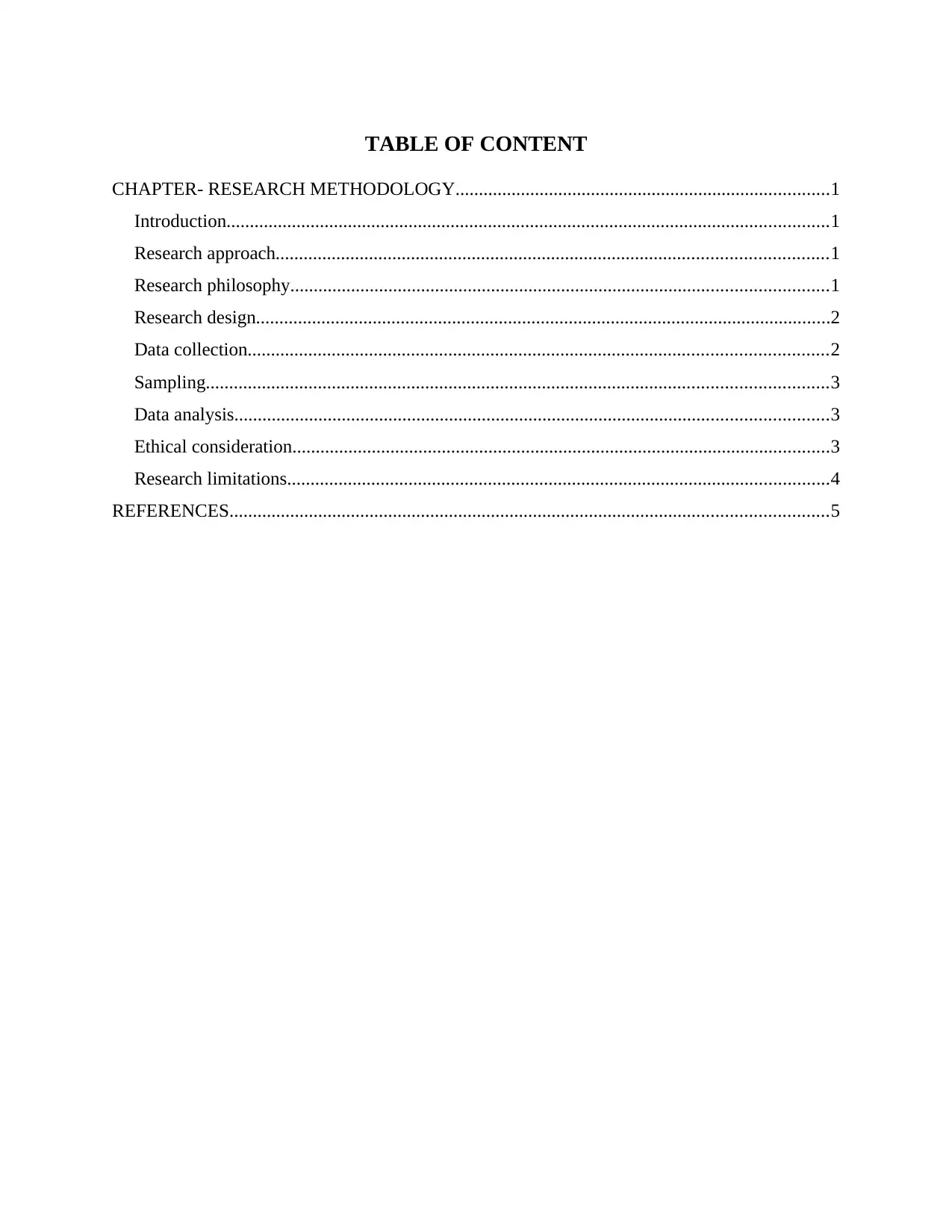
TABLE OF CONTENT
CHAPTER- RESEARCH METHODOLOGY................................................................................1
Introduction.................................................................................................................................1
Research approach......................................................................................................................1
Research philosophy...................................................................................................................1
Research design...........................................................................................................................2
Data collection............................................................................................................................2
Sampling.....................................................................................................................................3
Data analysis...............................................................................................................................3
Ethical consideration...................................................................................................................3
Research limitations....................................................................................................................4
REFERENCES................................................................................................................................5
CHAPTER- RESEARCH METHODOLOGY................................................................................1
Introduction.................................................................................................................................1
Research approach......................................................................................................................1
Research philosophy...................................................................................................................1
Research design...........................................................................................................................2
Data collection............................................................................................................................2
Sampling.....................................................................................................................................3
Data analysis...............................................................................................................................3
Ethical consideration...................................................................................................................3
Research limitations....................................................................................................................4
REFERENCES................................................................................................................................5
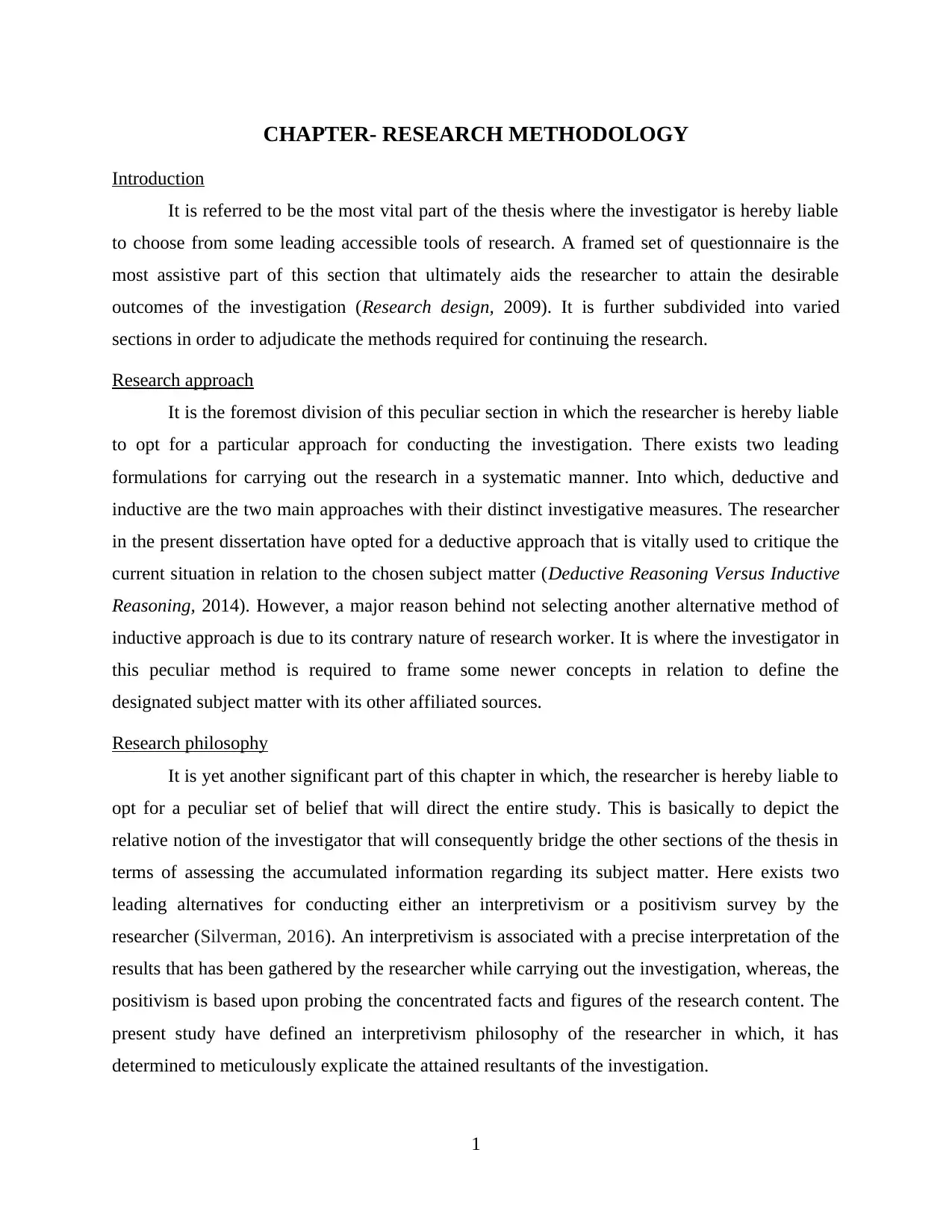
CHAPTER- RESEARCH METHODOLOGY
Introduction
It is referred to be the most vital part of the thesis where the investigator is hereby liable
to choose from some leading accessible tools of research. A framed set of questionnaire is the
most assistive part of this section that ultimately aids the researcher to attain the desirable
outcomes of the investigation (Research design, 2009). It is further subdivided into varied
sections in order to adjudicate the methods required for continuing the research.
Research approach
It is the foremost division of this peculiar section in which the researcher is hereby liable
to opt for a particular approach for conducting the investigation. There exists two leading
formulations for carrying out the research in a systematic manner. Into which, deductive and
inductive are the two main approaches with their distinct investigative measures. The researcher
in the present dissertation have opted for a deductive approach that is vitally used to critique the
current situation in relation to the chosen subject matter (Deductive Reasoning Versus Inductive
Reasoning, 2014). However, a major reason behind not selecting another alternative method of
inductive approach is due to its contrary nature of research worker. It is where the investigator in
this peculiar method is required to frame some newer concepts in relation to define the
designated subject matter with its other affiliated sources.
Research philosophy
It is yet another significant part of this chapter in which, the researcher is hereby liable to
opt for a peculiar set of belief that will direct the entire study. This is basically to depict the
relative notion of the investigator that will consequently bridge the other sections of the thesis in
terms of assessing the accumulated information regarding its subject matter. Here exists two
leading alternatives for conducting either an interpretivism or a positivism survey by the
researcher (Silverman, 2016). An interpretivism is associated with a precise interpretation of the
results that has been gathered by the researcher while carrying out the investigation, whereas, the
positivism is based upon probing the concentrated facts and figures of the research content. The
present study have defined an interpretivism philosophy of the researcher in which, it has
determined to meticulously explicate the attained resultants of the investigation.
1
Introduction
It is referred to be the most vital part of the thesis where the investigator is hereby liable
to choose from some leading accessible tools of research. A framed set of questionnaire is the
most assistive part of this section that ultimately aids the researcher to attain the desirable
outcomes of the investigation (Research design, 2009). It is further subdivided into varied
sections in order to adjudicate the methods required for continuing the research.
Research approach
It is the foremost division of this peculiar section in which the researcher is hereby liable
to opt for a particular approach for conducting the investigation. There exists two leading
formulations for carrying out the research in a systematic manner. Into which, deductive and
inductive are the two main approaches with their distinct investigative measures. The researcher
in the present dissertation have opted for a deductive approach that is vitally used to critique the
current situation in relation to the chosen subject matter (Deductive Reasoning Versus Inductive
Reasoning, 2014). However, a major reason behind not selecting another alternative method of
inductive approach is due to its contrary nature of research worker. It is where the investigator in
this peculiar method is required to frame some newer concepts in relation to define the
designated subject matter with its other affiliated sources.
Research philosophy
It is yet another significant part of this chapter in which, the researcher is hereby liable to
opt for a peculiar set of belief that will direct the entire study. This is basically to depict the
relative notion of the investigator that will consequently bridge the other sections of the thesis in
terms of assessing the accumulated information regarding its subject matter. Here exists two
leading alternatives for conducting either an interpretivism or a positivism survey by the
researcher (Silverman, 2016). An interpretivism is associated with a precise interpretation of the
results that has been gathered by the researcher while carrying out the investigation, whereas, the
positivism is based upon probing the concentrated facts and figures of the research content. The
present study have defined an interpretivism philosophy of the researcher in which, it has
determined to meticulously explicate the attained resultants of the investigation.
1
⊘ This is a preview!⊘
Do you want full access?
Subscribe today to unlock all pages.

Trusted by 1+ million students worldwide
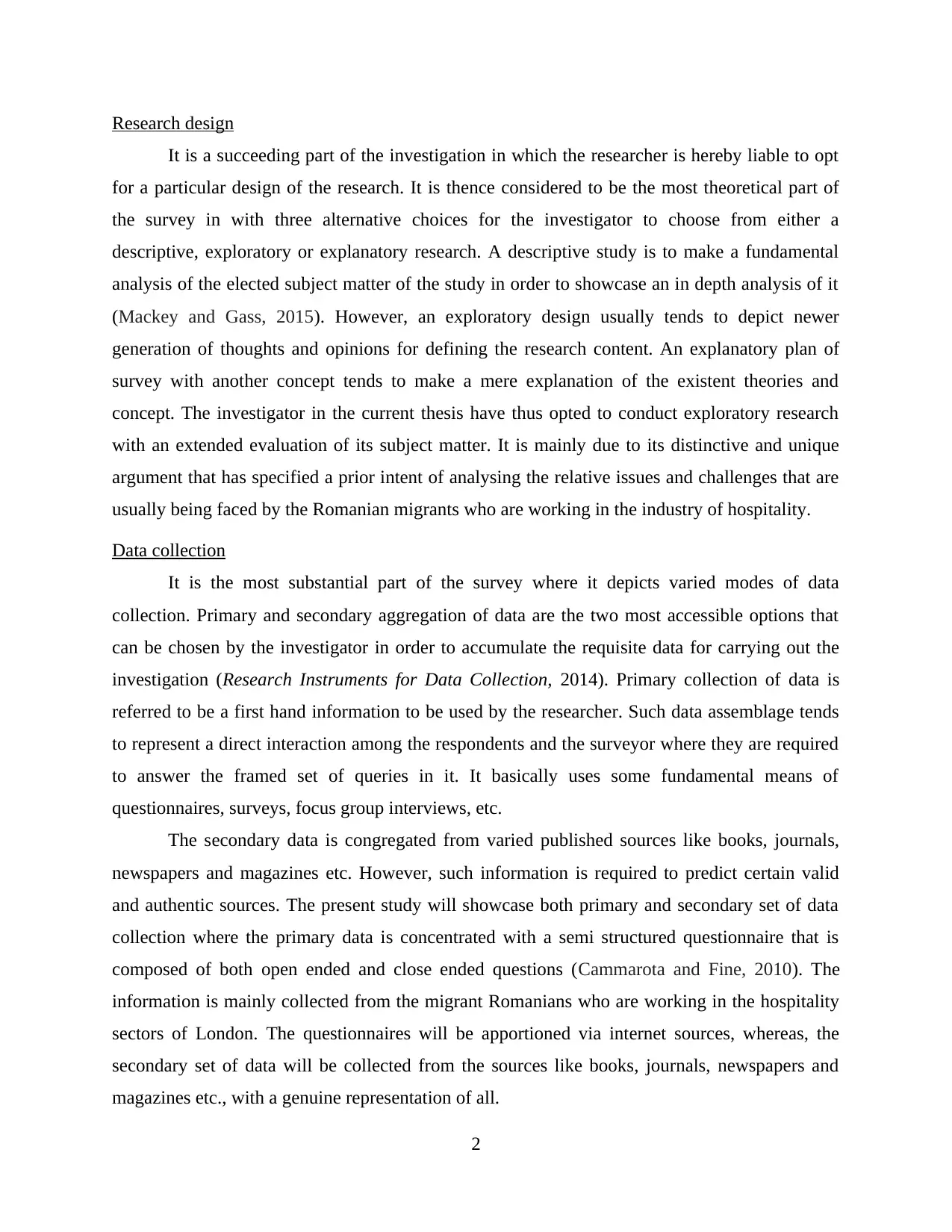
Research design
It is a succeeding part of the investigation in which the researcher is hereby liable to opt
for a particular design of the research. It is thence considered to be the most theoretical part of
the survey in with three alternative choices for the investigator to choose from either a
descriptive, exploratory or explanatory research. A descriptive study is to make a fundamental
analysis of the elected subject matter of the study in order to showcase an in depth analysis of it
(Mackey and Gass, 2015). However, an exploratory design usually tends to depict newer
generation of thoughts and opinions for defining the research content. An explanatory plan of
survey with another concept tends to make a mere explanation of the existent theories and
concept. The investigator in the current thesis have thus opted to conduct exploratory research
with an extended evaluation of its subject matter. It is mainly due to its distinctive and unique
argument that has specified a prior intent of analysing the relative issues and challenges that are
usually being faced by the Romanian migrants who are working in the industry of hospitality.
Data collection
It is the most substantial part of the survey where it depicts varied modes of data
collection. Primary and secondary aggregation of data are the two most accessible options that
can be chosen by the investigator in order to accumulate the requisite data for carrying out the
investigation (Research Instruments for Data Collection, 2014). Primary collection of data is
referred to be a first hand information to be used by the researcher. Such data assemblage tends
to represent a direct interaction among the respondents and the surveyor where they are required
to answer the framed set of queries in it. It basically uses some fundamental means of
questionnaires, surveys, focus group interviews, etc.
The secondary data is congregated from varied published sources like books, journals,
newspapers and magazines etc. However, such information is required to predict certain valid
and authentic sources. The present study will showcase both primary and secondary set of data
collection where the primary data is concentrated with a semi structured questionnaire that is
composed of both open ended and close ended questions (Cammarota and Fine, 2010). The
information is mainly collected from the migrant Romanians who are working in the hospitality
sectors of London. The questionnaires will be apportioned via internet sources, whereas, the
secondary set of data will be collected from the sources like books, journals, newspapers and
magazines etc., with a genuine representation of all.
2
It is a succeeding part of the investigation in which the researcher is hereby liable to opt
for a particular design of the research. It is thence considered to be the most theoretical part of
the survey in with three alternative choices for the investigator to choose from either a
descriptive, exploratory or explanatory research. A descriptive study is to make a fundamental
analysis of the elected subject matter of the study in order to showcase an in depth analysis of it
(Mackey and Gass, 2015). However, an exploratory design usually tends to depict newer
generation of thoughts and opinions for defining the research content. An explanatory plan of
survey with another concept tends to make a mere explanation of the existent theories and
concept. The investigator in the current thesis have thus opted to conduct exploratory research
with an extended evaluation of its subject matter. It is mainly due to its distinctive and unique
argument that has specified a prior intent of analysing the relative issues and challenges that are
usually being faced by the Romanian migrants who are working in the industry of hospitality.
Data collection
It is the most substantial part of the survey where it depicts varied modes of data
collection. Primary and secondary aggregation of data are the two most accessible options that
can be chosen by the investigator in order to accumulate the requisite data for carrying out the
investigation (Research Instruments for Data Collection, 2014). Primary collection of data is
referred to be a first hand information to be used by the researcher. Such data assemblage tends
to represent a direct interaction among the respondents and the surveyor where they are required
to answer the framed set of queries in it. It basically uses some fundamental means of
questionnaires, surveys, focus group interviews, etc.
The secondary data is congregated from varied published sources like books, journals,
newspapers and magazines etc. However, such information is required to predict certain valid
and authentic sources. The present study will showcase both primary and secondary set of data
collection where the primary data is concentrated with a semi structured questionnaire that is
composed of both open ended and close ended questions (Cammarota and Fine, 2010). The
information is mainly collected from the migrant Romanians who are working in the hospitality
sectors of London. The questionnaires will be apportioned via internet sources, whereas, the
secondary set of data will be collected from the sources like books, journals, newspapers and
magazines etc., with a genuine representation of all.
2
Paraphrase This Document
Need a fresh take? Get an instant paraphrase of this document with our AI Paraphraser
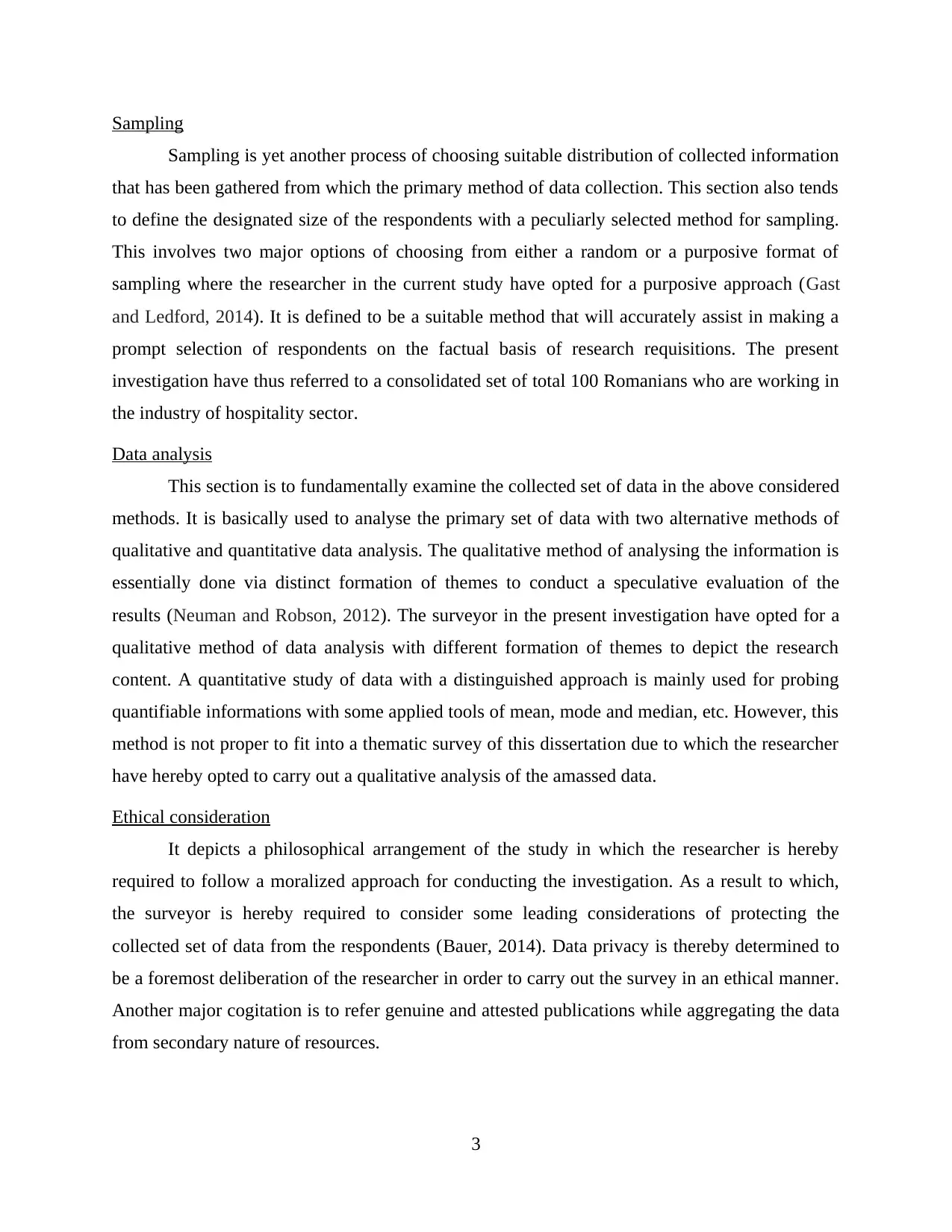
Sampling
Sampling is yet another process of choosing suitable distribution of collected information
that has been gathered from which the primary method of data collection. This section also tends
to define the designated size of the respondents with a peculiarly selected method for sampling.
This involves two major options of choosing from either a random or a purposive format of
sampling where the researcher in the current study have opted for a purposive approach (Gast
and Ledford, 2014). It is defined to be a suitable method that will accurately assist in making a
prompt selection of respondents on the factual basis of research requisitions. The present
investigation have thus referred to a consolidated set of total 100 Romanians who are working in
the industry of hospitality sector.
Data analysis
This section is to fundamentally examine the collected set of data in the above considered
methods. It is basically used to analyse the primary set of data with two alternative methods of
qualitative and quantitative data analysis. The qualitative method of analysing the information is
essentially done via distinct formation of themes to conduct a speculative evaluation of the
results (Neuman and Robson, 2012). The surveyor in the present investigation have opted for a
qualitative method of data analysis with different formation of themes to depict the research
content. A quantitative study of data with a distinguished approach is mainly used for probing
quantifiable informations with some applied tools of mean, mode and median, etc. However, this
method is not proper to fit into a thematic survey of this dissertation due to which the researcher
have hereby opted to carry out a qualitative analysis of the amassed data.
Ethical consideration
It depicts a philosophical arrangement of the study in which the researcher is hereby
required to follow a moralized approach for conducting the investigation. As a result to which,
the surveyor is hereby required to consider some leading considerations of protecting the
collected set of data from the respondents (Bauer, 2014). Data privacy is thereby determined to
be a foremost deliberation of the researcher in order to carry out the survey in an ethical manner.
Another major cogitation is to refer genuine and attested publications while aggregating the data
from secondary nature of resources.
3
Sampling is yet another process of choosing suitable distribution of collected information
that has been gathered from which the primary method of data collection. This section also tends
to define the designated size of the respondents with a peculiarly selected method for sampling.
This involves two major options of choosing from either a random or a purposive format of
sampling where the researcher in the current study have opted for a purposive approach (Gast
and Ledford, 2014). It is defined to be a suitable method that will accurately assist in making a
prompt selection of respondents on the factual basis of research requisitions. The present
investigation have thus referred to a consolidated set of total 100 Romanians who are working in
the industry of hospitality sector.
Data analysis
This section is to fundamentally examine the collected set of data in the above considered
methods. It is basically used to analyse the primary set of data with two alternative methods of
qualitative and quantitative data analysis. The qualitative method of analysing the information is
essentially done via distinct formation of themes to conduct a speculative evaluation of the
results (Neuman and Robson, 2012). The surveyor in the present investigation have opted for a
qualitative method of data analysis with different formation of themes to depict the research
content. A quantitative study of data with a distinguished approach is mainly used for probing
quantifiable informations with some applied tools of mean, mode and median, etc. However, this
method is not proper to fit into a thematic survey of this dissertation due to which the researcher
have hereby opted to carry out a qualitative analysis of the amassed data.
Ethical consideration
It depicts a philosophical arrangement of the study in which the researcher is hereby
required to follow a moralized approach for conducting the investigation. As a result to which,
the surveyor is hereby required to consider some leading considerations of protecting the
collected set of data from the respondents (Bauer, 2014). Data privacy is thereby determined to
be a foremost deliberation of the researcher in order to carry out the survey in an ethical manner.
Another major cogitation is to refer genuine and attested publications while aggregating the data
from secondary nature of resources.
3
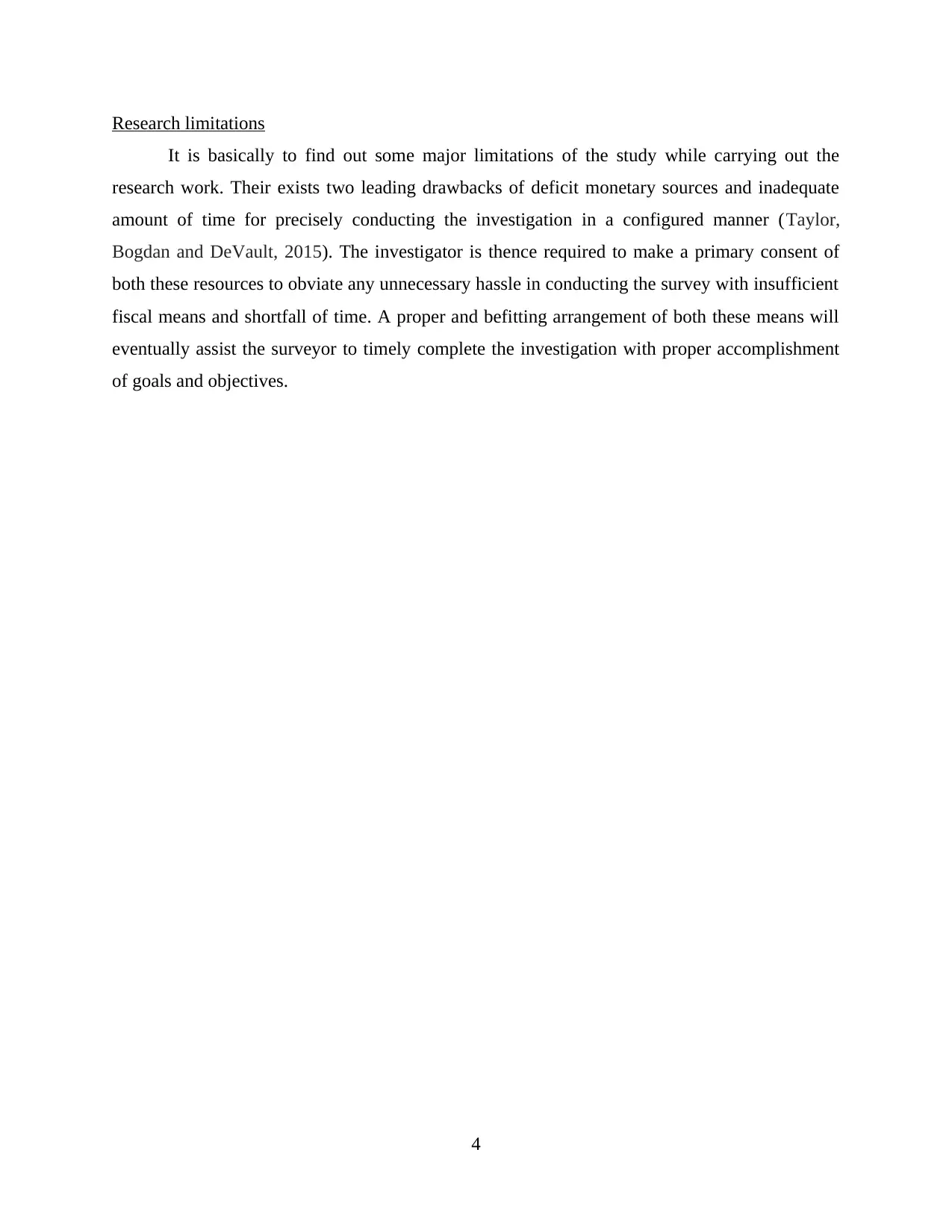
Research limitations
It is basically to find out some major limitations of the study while carrying out the
research work. Their exists two leading drawbacks of deficit monetary sources and inadequate
amount of time for precisely conducting the investigation in a configured manner (Taylor,
Bogdan and DeVault, 2015). The investigator is thence required to make a primary consent of
both these resources to obviate any unnecessary hassle in conducting the survey with insufficient
fiscal means and shortfall of time. A proper and befitting arrangement of both these means will
eventually assist the surveyor to timely complete the investigation with proper accomplishment
of goals and objectives.
4
It is basically to find out some major limitations of the study while carrying out the
research work. Their exists two leading drawbacks of deficit monetary sources and inadequate
amount of time for precisely conducting the investigation in a configured manner (Taylor,
Bogdan and DeVault, 2015). The investigator is thence required to make a primary consent of
both these resources to obviate any unnecessary hassle in conducting the survey with insufficient
fiscal means and shortfall of time. A proper and befitting arrangement of both these means will
eventually assist the surveyor to timely complete the investigation with proper accomplishment
of goals and objectives.
4
⊘ This is a preview!⊘
Do you want full access?
Subscribe today to unlock all pages.

Trusted by 1+ million students worldwide
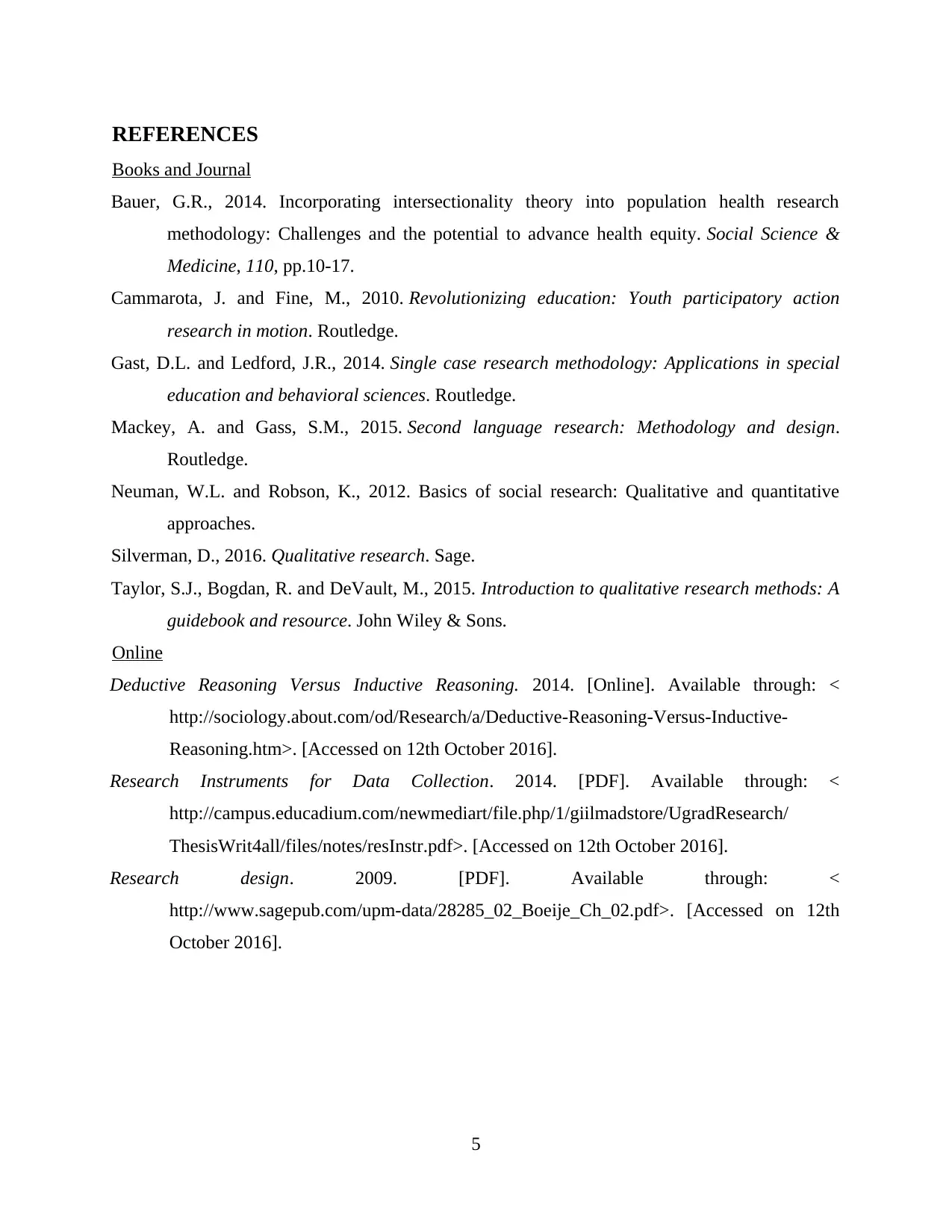
REFERENCES
Books and Journal
Bauer, G.R., 2014. Incorporating intersectionality theory into population health research
methodology: Challenges and the potential to advance health equity. Social Science &
Medicine, 110, pp.10-17.
Cammarota, J. and Fine, M., 2010. Revolutionizing education: Youth participatory action
research in motion. Routledge.
Gast, D.L. and Ledford, J.R., 2014. Single case research methodology: Applications in special
education and behavioral sciences. Routledge.
Mackey, A. and Gass, S.M., 2015. Second language research: Methodology and design.
Routledge.
Neuman, W.L. and Robson, K., 2012. Basics of social research: Qualitative and quantitative
approaches.
Silverman, D., 2016. Qualitative research. Sage.
Taylor, S.J., Bogdan, R. and DeVault, M., 2015. Introduction to qualitative research methods: A
guidebook and resource. John Wiley & Sons.
Online
Deductive Reasoning Versus Inductive Reasoning. 2014. [Online]. Available through: <
http://sociology.about.com/od/Research/a/Deductive-Reasoning-Versus-Inductive-
Reasoning.htm>. [Accessed on 12th October 2016].
Research Instruments for Data Collection. 2014. [PDF]. Available through: <
http://campus.educadium.com/newmediart/file.php/1/giilmadstore/UgradResearch/
ThesisWrit4all/files/notes/resInstr.pdf>. [Accessed on 12th October 2016].
Research design. 2009. [PDF]. Available through: <
http://www.sagepub.com/upm-data/28285_02_Boeije_Ch_02.pdf>. [Accessed on 12th
October 2016].
5
Books and Journal
Bauer, G.R., 2014. Incorporating intersectionality theory into population health research
methodology: Challenges and the potential to advance health equity. Social Science &
Medicine, 110, pp.10-17.
Cammarota, J. and Fine, M., 2010. Revolutionizing education: Youth participatory action
research in motion. Routledge.
Gast, D.L. and Ledford, J.R., 2014. Single case research methodology: Applications in special
education and behavioral sciences. Routledge.
Mackey, A. and Gass, S.M., 2015. Second language research: Methodology and design.
Routledge.
Neuman, W.L. and Robson, K., 2012. Basics of social research: Qualitative and quantitative
approaches.
Silverman, D., 2016. Qualitative research. Sage.
Taylor, S.J., Bogdan, R. and DeVault, M., 2015. Introduction to qualitative research methods: A
guidebook and resource. John Wiley & Sons.
Online
Deductive Reasoning Versus Inductive Reasoning. 2014. [Online]. Available through: <
http://sociology.about.com/od/Research/a/Deductive-Reasoning-Versus-Inductive-
Reasoning.htm>. [Accessed on 12th October 2016].
Research Instruments for Data Collection. 2014. [PDF]. Available through: <
http://campus.educadium.com/newmediart/file.php/1/giilmadstore/UgradResearch/
ThesisWrit4all/files/notes/resInstr.pdf>. [Accessed on 12th October 2016].
Research design. 2009. [PDF]. Available through: <
http://www.sagepub.com/upm-data/28285_02_Boeije_Ch_02.pdf>. [Accessed on 12th
October 2016].
5
1 out of 7
Related Documents
Your All-in-One AI-Powered Toolkit for Academic Success.
+13062052269
info@desklib.com
Available 24*7 on WhatsApp / Email
![[object Object]](/_next/static/media/star-bottom.7253800d.svg)
Unlock your academic potential
Copyright © 2020–2025 A2Z Services. All Rights Reserved. Developed and managed by ZUCOL.





